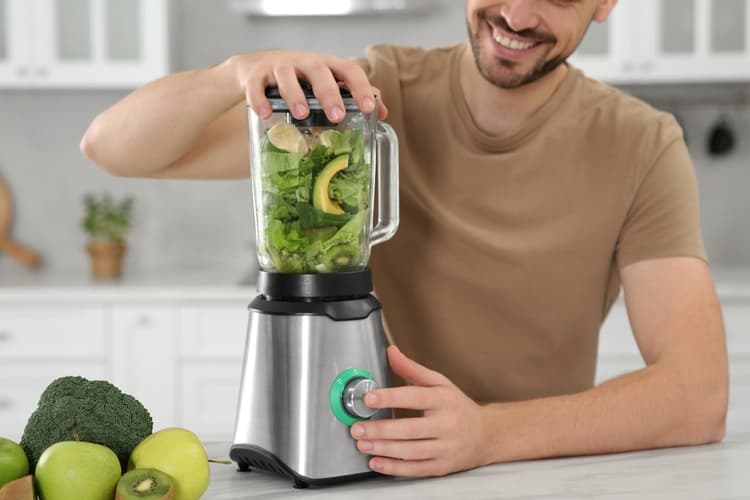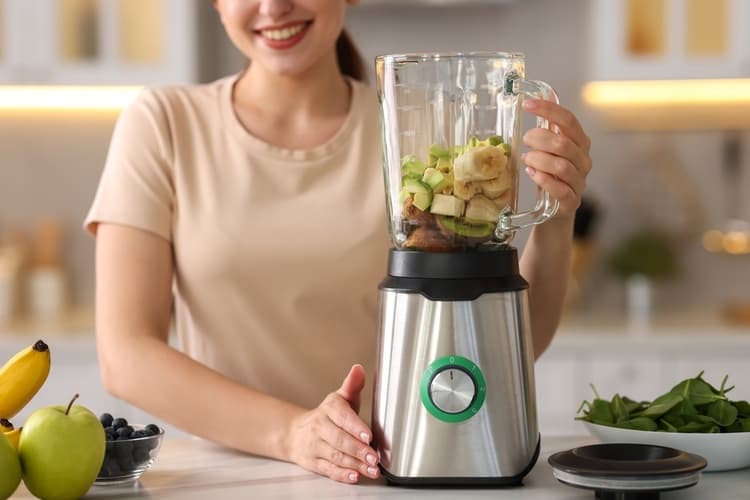How to Choose the Best Blender for Your Needs
Adam Stone • November 1, 2024 • 8 min
When it comes to choosing a blender, there are a variety of factors to consider, from the type of blender to specific features and budget. Understanding the different types of blenders and how each one serves various needs can help you make an informed choice.

In this guide, we’ll walk through everything from countertop and immersion blenders to senior-specific tips for finding the ideal blender.
How To Choose the Best Blender for Your Needs
Choosing the best blender depends largely on how you plan to use it. Some people want a blender primarily for making smoothies, while others need a versatile tool for everything from pureeing soups to grinding nuts. Consider how frequently you’ll use it and the types of foods you plan to blend.
A high-power blender, for instance, is ideal if you’re blending tougher ingredients like ice or nuts. These blenders generally have motors above 1,000 watts and can handle tougher jobs with ease. On the other hand, if you’re mainly interested in a blender for light tasks, a lower-wattage option may suffice. Another key factor is capacity—a large-capacity blender is useful for family-sized batches, whereas a single-serve or personal blender may be more convenient for individual portions.
Blender types vary significantly in terms of their ease of use, portability, and storage. Immersion blenders are compact and excellent for small jobs, while countertop blenders offer more power and versatility. Carefully evaluate the motor power, blade design, and additional settings or accessories. Finally, consider your budget and the warranties offered, as blenders can be a long-term investment.
Countertop Blenders Explained
Countertop blenders are one of the most popular types and are known for their versatility and power. These blenders sit on your counter and are perfect for various tasks, including making smoothies, soups, sauces, and crushing ice. Most countertop blenders come with multiple speed settings, and many have pulse functions for precise control over texture.
Most countertop models have jar capacities ranging from 24 ounces to over 60 ounces. If you frequently blend larger quantities, opt for a larger jar size to avoid blending multiple batches. Another consideration is jar material. Many countertop blenders come with glass or BPA-free plastic jars. Glass jars tend to be heavier but are resistant to staining and odors, while plastic jars are lightweight and durable.
Countertop blenders often have higher wattage motors, typically between 500 to 1,200 watts, making them suitable for blending harder ingredients. Consider models with features like pre-set programs (for smoothie, ice crush, or puree functions) if you want more convenience. Some high-end models can even serve as food processors, increasing their overall utility.
Immersion Blenders: What You Need to Know
Immersion blenders, or stick blenders, are compact and highly convenient for those with limited kitchen space. They’re held by hand and can be immersed directly into pots, bowls, or cups, making them ideal for blending soups, sauces, and small batches of smoothies without transferring ingredients. Immersion blenders are generally less powerful than countertop models but are perfect for specific blending tasks.
These blenders typically come with single or variable-speed settings. Models with variable speeds allow for more control when handling delicate recipes or blending thicker ingredients. Additionally, some immersion blenders come with attachable accessories like whisks and chopping bowls, which can expand their functionality.
One of the significant advantages of immersion blenders is their ease of cleaning. They’re often dishwasher-safe or have removable blending heads that make them easy to clean by hand. When considering an immersion blender, prioritize ease of grip, weight, and cord length (or consider a cordless model) to ensure comfortable use, especially if you’ll use it for extended blending.
Personal Blenders Overview
Personal blenders, also known as single-serve blenders, are perfect for making individual portions of smoothies or protein shakes. These blenders typically feature smaller, portable jars that double as travel cups, making them ideal for on-the-go users. With jars typically holding 12 to 24 ounces, personal blenders are excellent for quick, single servings without excess cleanup.
These blenders are compact and often have fewer parts than full-size models, making them easy to store in small spaces. Many personal blenders come with a simple one-touch blending option, ideal for quick preparation. They also tend to be more affordable than larger, high-power models.
Personal blenders are generally designed for softer ingredients like fruits, vegetables, and protein powders, so they may struggle with harder items like ice or nuts. Some higher-wattage models, however, can handle these tougher ingredients with ease. If you’re looking for a blender specifically for single-serve beverages, personal blenders are often the most practical choice.
What to Look for in a Blender
When buying a blender, certain features can make all the difference in usability and performance. Consider the motor power first—higher wattage typically means the blender can handle tougher ingredients. For basic blending tasks, a motor in the 300-700 watt range may be sufficient, while heavy-duty use may require 1,000 watts or more.
The blade design is also crucial. Stainless steel blades tend to be more durable and efficient, especially for crushing ice or chopping nuts. Blender jars vary in material, with options including plastic, glass, and stainless steel. Plastic jars are lightweight but can retain stains and odors, while glass jars are heavier and more resistant to discoloration.
Additional features to consider are pulse functions, variable speeds, and pre-set programs, all of which enhance versatility. If you’re looking for a quiet blender, check the decibel rating, as high-power models can be noisy. Finally, assess the warranty and customer reviews to ensure the brand’s reliability and quality.
How to Find Discounts on Blenders
Finding discounts on blenders requires knowing when and where to look. Many retailers offer discounts during holiday sales, such as Black Friday and New Year sales. Checking online marketplaces often reveals seasonal and flash sales, and sometimes, brands offer direct discounts on their official websites.
You can also find discounts through coupon websites, which may offer codes for both online and in-store purchases. Signing up for newsletters from popular kitchen appliance retailers can give you early access to promotions and exclusive discount codes. Refurbished blenders are another option for budget-conscious buyers, as they’re often available at significantly reduced prices and come with warranties.
Another way to save is by checking local appliance stores for seasonal clearances or opting for older models, which may be discounted when newer versions are released. Don’t forget to look for bundle deals where blenders come with additional accessories like blending cups or travel lids, which add value to your purchase.

What Are the Most Reliable Blender Brands
Some brands have consistently proven to deliver reliable and high-quality blenders, with brands often varying in terms of power, durability, and features. Brands known for reliability typically have strong warranties and excellent customer support.
High-end brands often offer powerful motors and advanced features, making them popular for professional and home kitchens alike. Mid-range brands provide quality options at more affordable prices and are suitable for everyday blending tasks. Budget-friendly brands can be reliable as well, especially for lighter use or single-serve blending needs.
Customer reviews, product longevity, and warranty terms are essential to consider when assessing brand reliability. A brand with a reputation for responsive customer service and consistent performance is generally a good choice.
5 Ways to Save Money on Blender Purchase
Saving money on a blender involves strategic shopping, especially with the wide range of price points in the market. Here are five effective strategies:
- Shop during holiday sales - Take advantage of major sales events for the best deals.
- Look for refurbished models - These often come with warranties at a reduced price.
- Use price comparison websites - These sites help you find the lowest prices across retailers.
- Buy older models - When newer versions are released, older models usually drop in price.
- Sign up for newsletters - Many stores offer exclusive discounts to subscribers.
Using these strategies can help you get the best deal without sacrificing quality or functionality. If you’re patient and diligent, finding a high-quality blender within your budget is achievable.
Specifically for Seniors: Tips for Buying a New Blender
When it comes to buying a blender for seniors, specific features can make a significant difference in usability. Weight and ease of handling are crucial factors, as lighter blenders are easier to maneuver. Look for ergonomic designs that are comfortable to hold, especially if choosing an immersion blender.
Consider blenders with simple, easy-to-read controls and buttons, as these are more user-friendly. Models with one-touch settings can also simplify blending tasks, and quieter motors can be beneficial if noise sensitivity is a concern. Cordless or rechargeable blenders add convenience and reduce clutter, while dishwasher-safe parts make cleaning much easier.
Lastly, ensure that the blender has an easy-to-grip jar or handle, as this reduces the strain on the hands and wrists. Blenders with intuitive designs and senior-friendly features provide both ease and comfort.
Where to Order Blenders Online
There are numerous reputable online platforms for ordering blenders. Major e-commerce sites carry a wide range of options, from high-end professional blenders to affordable personal models, and often include customer reviews to help you make an informed choice. Many popular kitchen appliance retailers also have their online stores with exclusive models and warranty options.
Some blender brands sell directly through their websites, where you can often find exclusive discounts or loyalty programs. If you’re looking for discounted models, online outlet stores sometimes carry last season’s products at a lower price. Additionally, many sites offer customer-friendly return policies, making it easier to try out your purchase and return it if it’s not the right fit.
Conclusion
Choosing the right blender involves assessing your needs, budget, and the specific tasks you plan to perform. With various types of blenders available, from countertop and immersion blenders to personal and senior-friendly models, there’s something to suit every lifestyle. Remember to look out for sales, consider reliable brands, and prioritize features that align with your needs to get the best blender for your home.
Sources
- Consumer Reports – Best Blenders
- Good Housekeeping – Top Blender Brands
- Kitchen Appliance Guide – How to Buy a Blender
- Senior-Friendly Blender Tips
Disclaimer: This article provides general information and is not intended as specific purchasing advice. We do not sell or endorse any products and recommend consulting individual retailers or manufacturers for further information.